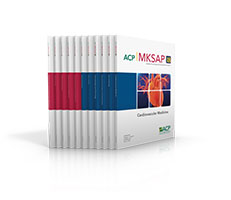 MKSAP has been trusted by internists since 1967 as the best resource for updating knowledge. Every 3 years more than 100 subject matter experts completely revise, update, and rewrite MKSAP using the latest clinical information.
MKSAP has been trusted by internists since 1967 as the best resource for updating knowledge. Every 3 years more than 100 subject matter experts completely revise, update, and rewrite MKSAP using the latest clinical information.
This Q&A was obtained from the MKSAP® 18 edition of the Medical Knowledge Self-Assessment Program. Learn more about the new MKSAP® 19 edition and pre-order your copy today. You can expect customized learning plans, more content sections, a newly integrated Board Basics study guide, and multimedia enhancements.
MKSAP 18 Q & A
A 36-year-old woman is evaluated in the emergency department for progressive dyspnea. She gave birth 3 weeks ago. The pregnancy and delivery were uncomplicated. She has no history of cardiovascular disease.
On physical examination, temperature is normal, blood pressure is 100/72 mm Hg in both arms, pulse rate is 102/min and regular, and respiration rate is 26/min. The estimated central venous pressure is elevated. Cardiac palpation reveals a diffuse apical impulse. The S1 and S2 are soft. An S3 and S4 are present. A grade 2/6 holosystolic murmur is heard at the apex. Crackles are auscultated bilaterally.
An electrocardiogram demonstrates sinus tachycardia without ST-T–wave changes. Transthoracic echocardiogram reveals ventricular dilatation with global reduction in contractility; the left ventricular ejection fraction is 30%.
Which of the following is the most likely diagnosis?
A: Acute aortic dissection
B: Acute pulmonary embolism
C: Peripartum cardiomyopathy
D: Takotsubo cardiomyopathy

